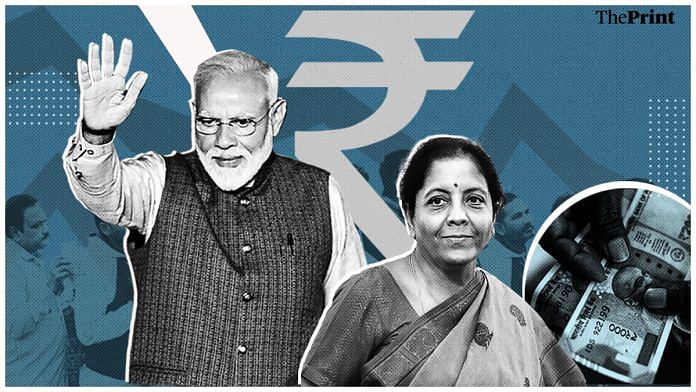After Finance Minister Nirmala Sitharaman announced cuts in corporate tax from 30 per cent to 22 per cent last week, the stock market (Nifty and Sensex) has seen a 3 per cent jump with the Sensex also rising by 1,075 points. The markets have remained stable since.
ThePrint asks: What are the next 5 steps Modi govt needs to take after corporate tax cut?
Modi govt must restart stalled housing projects & encourage foreign companies to manufacture in India
 Devendra Pant
Devendra Pant
Chief Economist, India Ratings and Research
It is important to understand that the economy is currently facing is a growth slowdown, which has mainly resulted from a slowdown in demand. This is unlike in the past where the economic slowdown had stem from a supply-side slump. The slowdowns earlier were cyclical, and did not really impact consumption patterns so much as it has impacted in the current phase. Unless there are demand boosters, it is unlikely that the economy will come back to a sustained growth path in a short time.
What the government needs to do is restart the stalled housing projects in the real estate sector. Once these housing projects are completed, it will boost both consumption and demand. Currently, this delay is eating into people’s savings, and impacting their consumption patterns. We need to understand that household are the only institutions that is having a positive net savings (savings-investment). The public sector, private sector, and government all have negative net savings.
The cuts in corporate tax are meant to boost investment, but we are in a situation where there demand growth is very weak. People will make investments only when demand increases. In order to do this, consumption patterns need to be addressed. For example, if Apple’s production moves from China to India, then it will boost India’s exports — and also simultaneously address the problem of unemployment. Most importantly, it will address the problem of lack of consumption because there is a huge demand for Apple products in India.
The cuts in corporate tax are one way of facilitating a potential shift like this. Land and labour are critical factors in increasing demand and a faster resolution in issues related to land and labour will help.
Views are personal
Also read: Sensex jumps for second day on govt’s corporate tax cut boost
Modi govt now needs to cut personal income tax, and infuse money in rural areas
 Himanshu
Himanshu
Associate Professor at Centre for Economic Studies and Planning, JNU
Everyone now agrees that the current economic slowdown is not because companies are not manufacturing enough, but because there is a lack of demand across all sectors — be it biscuit companies or the automobile industry. After the move to cut the corporate tax rate, we need to realise that the problem is not entirely with corporates, but that they are sitting on inventories. So, if they produce goods, the question is who will buy them? And this issue is not going to be resolved by the corporate tax cut alone.
The cuts in the corporate tax might entice producers to invest, but it will not help solve the problem of slackening demand. What it mainly does is lift sentiments of investors, but they were always bullish anyway. In order to revive the economy from this slump, Modi government needs to focus on increasing demand. To do so, it can look at measures such as a cut in personal income tax or infuse money in rural areas to increase the demand there. These are more necessary
After corporate tax cut, Modi must now focus on fiscal discipline, banking reforms, MSMEs, direct taxation
 Radhika Pandey
Radhika Pandey
Fellow, National Institute of Public Finance and Policy
The Narendra Modi government has taken the first big step to address the slowdown by announcing steep cuts in corporate tax rates.
Fiscal discipline: The cut in corporate tax and the associated revenue loss could result in the government substantially deviating from its fiscal deficit target. The Modi government should try to address the fiscal implications of tax cut by reducing unproductive expenditure and pursuing aggressive asset monetisation. In the absence of this, higher fiscal deficit could result in higher borrowings, leading to higher interest rates that would be counter-productive to private investments.
Credit for MSMEs: These have long been recognised as engines of growth. Their access to formal credit needs to improve so that they can contribute materially towards economic growth.
Banking sector reforms: Greater competition in the banking sector would aid in improving credit availability. This would require bringing the Financial Resolution and Deposit Insurance Bill back to the agenda. The apprehensions raised at the time of rollback of the FRDI Bill need to be addressed and a prompt resolution framework for banks and financial firms just as we have the IBC for non-financial firms should be put into place.
Reforms in direct taxation: This should be the next agenda for tax reform. The recommendations of the Direct Tax Code should be considered by the government. Rationalising direct taxes in particular the income tax slabs, reducing exemptions, increasing the tax base, and simplifying compliance should be the key elements of tax reform.
Views are personal
Also read: Nirmala Sitharaman’s corporate tax cut is tangential, because lack of demand ails economy
Apart from corporate tax cut, Modi govt needs to revive rural economy and increase farm investment
 Narendra Pani
Narendra Pani
Professor and Dean, School of Social Sciences, National Institute of Advanced Studies
By bearing a revenue loss of as much as Rs 1.45 lakh crores annually after slashing corporate tax rate for large firms, the Modi government is clearly banking on the current crisis that is on the supply side of the economy. But, if the constraints are on the demand side, as many believe they are, there is no reason why these companies should increase the production
of their products they cannot sell. Prudent economic decision making would demand that they instead invest what they have saved from the tax cuts in more lucrative markets across the world.
Without the quick fix of rural doles, the government would need to take steps that would regenerate the rural economy. The following five measures would help.
First, revive an effective procurement system that would ensure farmers get remunerative prices without causing food inflation.
Second, encourage farm investment by creating an effective system of forwarding markets that will inform farmers — at the time of sowing — what price he or she will get at the time of harvest.
Third, set up local institutions that would, for a nominal fee, cultivate fallow land. This would enable farmers to earn money from their lands even as they seek work elsewhere.
Fourth, enable these institutions to tap local capital, both farm and non-farm.
Fifth, revive regional stock exchanges so that they can tap widespread small capital. Such a farm-led rural revival would help boost rural demand, which could in turn attract the investment that has been released through the tax cuts made for big businesses.
By Revathi Krishnan, journalist at ThePrint




Privatisation, in the true sense of the term, with transfer of management control to the private sector. A guillotine over all loss making PSUs / PSBs, no more fiscal support. To be extended to profit making ones as well, in due course, when valuations improve. 2. Single out banking and power sectors for reform. Privatisation, coupled with matter of course grant of new licences to rock solid applicants for the former. A graduated increase in power tariffs for agriculture, spaced out over ten years. 3. Scaling back the intense pressure tax authorities are generating to raise revenue from a troubled economy.